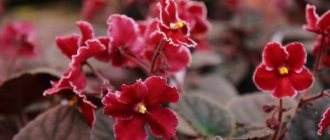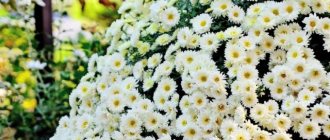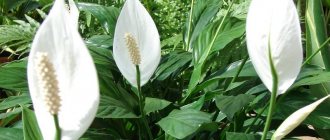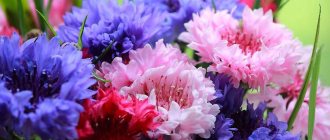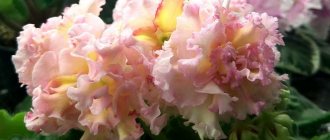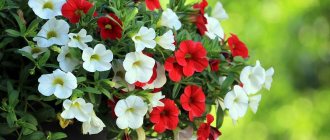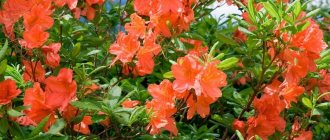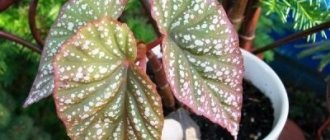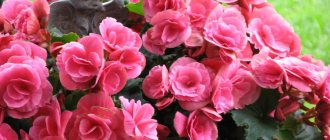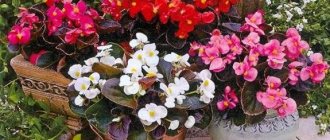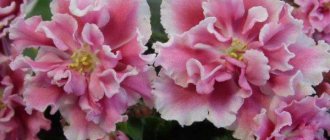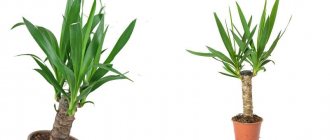How long does it take for begonia to grow from seeds, when to plant
Ampelous begonias reproduce in three ways: seeds, cuttings, and cutting tubers into pieces. The most popular method is propagation by grains. According to gardeners, mid-February is considered the optimal time for planting planting material. Seedlings need daily additional lighting. The recommended daylight hours are 13-14 hours.
ampelous begonia from seeds
Seeds germinate 2 weeks after planting. Sprouts may stop developing for some time. Don't worry, this is completely normal. During this period, water the plant especially carefully using a sprayer. Grown flowers are transplanted into separate containers.
How to germinate ampelous begonia seeds
The seeds of the decorative crop are germinated on thin cotton fabric. To do this prepare:
- a piece of gauze;
- flower seeds;
- water.
The gauze is moistened generously and transferred to a convenient container. Seeds of decorative crops are placed on top of the cotton fabric. The container is transferred to a bright and warm room. After 2 days, the seeds will begin to germinate.
Important! Germination of planting material allows you to accelerate the emergence of seedlings and achieve early flowering.
Ampelous begonia from seeds growing at home
Decorative crops can be grown at home. In order for the seedlings to be healthy and strong, it is important to follow the recommendations of experienced gardeners.
Soil for sowing
For planting, prepare a suitable soil mixture, which consists of 3 parts leaf soil, 3 parts chernozem soil, 1 part sand and 0.5 parts perlite. After preparation, the substrate is disinfected. To do this, use one of the methods suggested below:
- Freezing the ground.
- Treating the substrate with high temperature steam.
- Wet the soil abundantly with a weak solution of potassium permanganate.
- Watering the soil with boiling water.
After waiting until the temperature of the soil mixture drops to 20°C, flower growers begin planting work.
Advice! Instead of special soil, coconut/peat tablets are often used for planting ornamental crops.
Containers for sowing
Various containers are used for sowing grains. Below you can familiarize yourself with the features of growing begonia in each of them.
Napkins
A spacious container is covered with several layers of paper napkins, which need to be moistened generously. The seeds are poured onto paper, and the seedling boxes are covered with cling film and transferred to a well-lit room. After 3-4 days, the grains sprout. At this point, the film is removed from the pots.
Do not allow paper napkins to dry out. The finished sprouts are carefully removed and transplanted into the ground. Plants can be planted together with paper.
Peat tablets
The seeds are sown immediately and in peat tablets. For this, flower growers:
- Cover the surface of the bottom of the plastic container with a viscose napkin to achieve uniform distribution of moisture.
- Peat tablets provide abundant moisture. After they increase in volume, remove excess moisture. You can water them with a biogrowth stimulator.
- Make small holes in the tablets using a toothpick.
- The grains are evenly distributed on the tablets.
- The container is covered with a transparent lid and transferred to a warm, well-lit place. The cover is systematically removed for ventilation to prevent the formation of condensation. The room temperature is maintained within 19-20°C.
In winter, additional lighting is provided with a phytolamp. The recommended daylight hours are 13 hours. As soon as 3 leaves are formed on the plants, the begonia seedlings are transplanted into separate pots.
Pots
If you plant seeds directly into pots, they will not germinate well. This process can last 12-15 days. During this period, infections may manifest themselves, so high-quality seeds and disinfected soil are used for planting.
The pots with the planted grains are transferred to a room where the temperature reaches 25°C. The soil is systematically moistened. The recommended length of daylight is 13 hours, so plants need to be illuminated with a phytolamp.
To avoid mold, it is important to adhere to recommendations regarding germination conditions, which include:
- using sterile soil;
- regular loosening of the soil;
- proper watering;
- systematic ventilation of sprouts.
The room temperature should be within 20-22°C. As soon as 3 leaves are formed on the seedlings, the young plants are transplanted into separate, larger containers.
Seedling care
In order for seedlings to grow healthy and strong, you should properly care for them. Below you can familiarize yourself with the features of caring for a beautiful flowering plant.
Watering
The soil is moistened regularly. It is recommended to pour water into trays, since the use of overhead watering often leads to injury to tender shoots.
Advice! Do not pour water into the middle of the flowers. This will make it possible to avoid rotting of the root system.
Top dressing
To feed seedlings, use ready-made complex fertilizers intended for indoor plants. But it is better not to apply fertilizers that contain nitrogen into the soil. Nitrogen makes the stems watery, which increases the likelihood of rotting of the green mass.
Picking
60 days after sowing, the seedlings will begin to form 3-4 leaves. During this period, young plants need picking. A layer of drainage and soil mixture are poured into spacious pots and flowers are planted. The recommended height of picking pots is 10-15 cm.
Advice! To decorate hanging baskets, 3-5 plants are planted in flat wide pots at a time.
Lighting
When growing hanging begonia with seeds, it is important to create optimal conditions for the full growth and development of the crop. The room in which the flower pots are placed should have bright, diffused light. Do not allow direct sunlight to hit the foliage. Begonia is a tropical crop. That is why it is provided with high air humidity (60-70%).
What kind of plant is this?
Begonia is a beautiful plant that people not only like to grow at home, but also decorate parks, gardens, and public gardens with it. This flower belongs to the large family of begoniaceae. More than 900 species of begonias that are found in the wild belong to this genus and at least 2000 hybrid specimens that were bred artificially.
Back in the 17th century, the plant was described by Michel Begon, thanks to whom the flower got its name.
Reference! Only 100 years later, begonia began to be used as a decorative flower.
Among the rich variety of species of this plant, there are those that can easily fit into an egg cup, although there are also those for which it is time to dedicate an entire wall in the greenhouse.
Features of sowing ampelous begonia seeds
Decorative culture differs from other flowers in its harmony, attractiveness and tenderness. To grow healthy and strong bushes that will delight you with abundant flowering and gorgeous asymmetrical petals, you should adhere to the peculiarities of sowing plant seeds. Below you can find information on how to grow ampelous begonia from seeds.
Variety Chanson
Double and semi-double flowers of a perennial that does not overwinter in open ground are painted in dark red and vanilla-yellow tones. The bushes consist of 6-8 main shoots. The diameter of the regularly shaped flowers reaches 7-8 cm. The seeds are sown for seedlings in early January. Planting material is planted in spacious boxes filled with a drainage layer and a suitable soil mixture. Seeds are sown superficially, avoiding deepening. The seedling boxes are moved to a room with bright, diffused light.
Tuberous
The soil for planting tuber crops should be slightly acidic. The plant's grains are very small. To facilitate the planting process, you can mix them with a small amount of sand. Planting material is sown or pressed one at a time into a pre-moistened soil mixture.
Ampelous F1 Venus
Flower seeds of the Venus F1 variety are sown in a soil mixture that consists of 1 part sand, 4 parts leaf soil and 1 part turf. The surface of the bottom of the seedling boxes is covered with a layer of expanded clay and crushed shards. The grains should not be buried in the ground. They are placed on the surface of the soil and lightly sprinkled with sand.
Carmen
Planting material of this variety is sown in early February. The soil should be peaty and loose. It can be purchased in a store or prepared at home by combining 1 part fertile soil, 1 part leaf soil, 1 part humus and 0.5 parts sand. The grains are carefully distributed over the surface of the soil and lightly sprinkled with sand.
Hellas
Flower growers recommend planting the variety for seedlings in the last week of February. It is convenient to do sowings in spacious boxes. The soil is moistened abundantly 4-5 hours before planting. Small grains are carefully distributed over the surface of the soil mixture and sprinkled with sand.
Illumination White F1
Ornamental crops are planted in mid-February. Seeds of the Illumination White F1 variety are sown in seedling boxes, the depth of which does not exceed 20 cm. The soil is moistened as the top layer dries.
Variety Margarita
This variety of beautiful flowering plant is planted in fertile soil. Before sowing the grains, the soil is moistened abundantly. Sowing is carried out in mid-February.
Diseases and pests of everflowering begonia
Care errors, primarily stagnation or lack of moisture in the soil , weaken the plant and provoke its defeat by powdery mildew . In this case, you need to optimize watering and treat the begonia with fungicides.
The combination of high humidity and low temperature leads to the development of root or leaf rot .
If the process has just begun, you should urgently optimize the temperature and humidity conditions and remove damaged parts.
In case of severe damage, you will have to root cuttings cut from healthy shoots and keep them in appropriate conditions, and get rid of the rest of the plant.
Begonia can be attacked by whitefly, thrips and scale insects . As a first measure, remove pests using a cotton swab dipped in alcohol or treatment with a soap solution. The most effective pest control is systemic insecticides.
In a room with humidified air, where it is warm and light all year round, the ever-blooming begonia (Begonia semperflorens) fully lives up to its promising botanical name, almost continuously forming and unfurling flower buds throughout all four seasons.
Forum, reviews
Below you can read reviews from flower growers who grow hanging begonias from seeds at home.
Margarita, 39 years old, Moscow: “The main decoration of my garden has always been begonia. Numerous flowers on cascading stems look simply amazing. A couple of years ago I started growing ornamental crops at home. I purchase planting material only from a trusted manufacturer. I immediately plant the grains in peat tablets. The seedlings grow strong, healthy and delight with abundant flowering.”
Angelina, 47 years old, Saratov: “Every year I plant begonia at my summer cottage. I grow decorative seedlings myself. I sow the seeds in pots at the end of February, and transplant them into open ground no earlier than May 1st. I place containers with young plants in a room with bright, diffused light. The room temperature reaches 22°C. The flowering of the decorative crop continues for several months.”
Types of begonia
In total there are about a thousand species of begonias. In addition, the work of breeders has bred more than two thousand hybrids, while the number of varieties is constantly growing. The most popular types are: royal begonia, tuberous, ever-blooming, elatior, ampelous and tiger.
Royal begonia
Decorative foliage form, represented by many varieties and hybrids.
The plant consists of a thickened rhizome and spectacularly colored heart-shaped leaf blades. The leaves can be slightly pubescent or glabrous, up to 20 cm wide and up to 30 cm long, with a rugged, serrated edge. Various colors, ranging from brown and bronze to purple and lilac shades, with small spots of silver or reddish shades. There are varieties with almost black leaves with small scarlet patches. These begonias bloom inconspicuously, with small pink flowers, which I try to remove at the bud stage. Most often, collectors can find the following varieties:
- "Silver Greenheart"
- "Chocolit Cream";
- "Evening Glow";
- "Hallelujah"
Begonia Silver Greenheart
Begonia Chocolate Cream
Begonia Evening Glow
Begonia Hallelujah
Tuberous begonia
It is the fruit of the complex work of breeders. These are beautifully flowering plants, which are a small bush 30-40 cm high, formed from a fleshy stem, asymmetrical leaves and a tuberous rhizome. The main advantage of such bush begonias is their large flowers, reminiscent of roses or peonies. These can be simple or double buds of different sizes and colors. Colors range from white, pink and various shades of red and yellow.
There are also two-color varieties, such as begonia "Marmorata", its double flowers are decorated with streaks and a border on the petals. The most popular are:
- "Picoty Harlequin";
- "Bud de Rose";
- Duck Red.
Begonia Picoti Harlequin
Begonia Bud de Rose
Begonia Duck Red
Begonia everblooming
Suitable for growing not only in potted conditions in an apartment, but also used for landscaping in open ground. With proper care, such an indoor begonia will delight you for many years; it is grown in a flowerbed as an annual. This type stands out for its compactness. The tallest varieties grow no more than 30 cm, and the height of miniature begonias is only 8-10 cm. Begonia looks very harmonious in a flowerbed next to coleus.
The plant is a bush with a fleshy, erect stem and oval, slightly pubescent leaves. The color of the leaf blade can be all shades of green, as well as burgundy or red-brown. Flowering is not very abundant; most often there are from 2 to 4 simple flowers on the peduncle. Color varies from white to red, and there are varieties with edged petals. The flowering of such begonias is long and continuous, until frost. The following varieties are especially popular:
- "Bada boom";
- "Olomoets";
- "F1 Ambassador"
Begonia Bada boom
Begonia Ambassador F1
Begonia Olomoec
Begonia elatior
The most common hybrid flowering form, distinguished by abundant flowering. It is a bush no more than 40 cm high, with thick shoots and fleshy heart-shaped leaves up to 8 cm long. The leaf blade has a glossy outer surface of a rich green color and a matte inner surface of a lighter shade. It has large double flowers of various colors and shades.
Most often, fans can find the following varieties:
- "Renaissance";
- "Berlin";
- "Sharlah."
Begonia elatior
Begonia ampelous
An excellent plant that can be seen as a bright decoration for balconies and terraces. Begonia has cascading shoots that cascade downwards. Each stem is densely covered with a large number of flowers. You can see semi-double, double, densely double rose flowers or simple buds of various colors and shades. Varieties with two-color petals have also been bred. Opened buds can be of different sizes, gigantic, hiding all the foliage, or miniature, not exceeding 2 cm in diameter.
The most common hanging begonias are the following varieties:
- "Christie";
- "Roxana";
- "Katie."
Begonia ampelous
Begonia tiger
One of the decorative deciduous species that is suitable for growing in apartment conditions. The plant forms a small bush, no more than 25 cm high. It has creeping shoots and leaves of a soft green color. Each leaf blade is decorated with small spots of brown, brown or black color. The top of the leaf is smooth, with a velvety tint, the reverse side is covered with low pile.
Like other similar species, the flowering of tiger begonia is not particularly attractive; I try to remove flower stalks at the budding stage. Varieties such as “Tiger” and “Cleopatra” will decorate any home collection.
Begonia tiger
